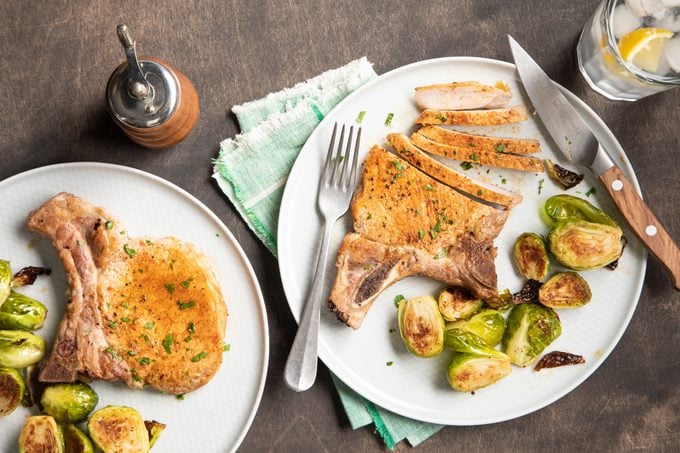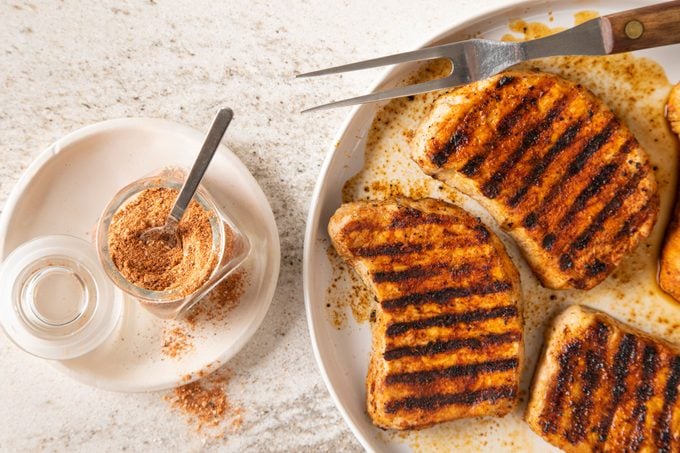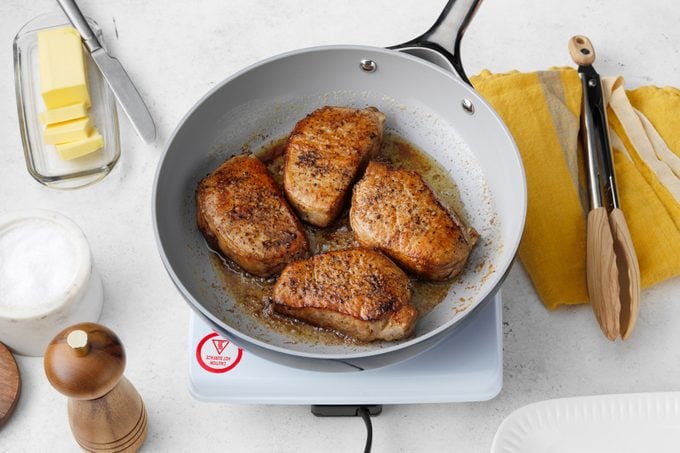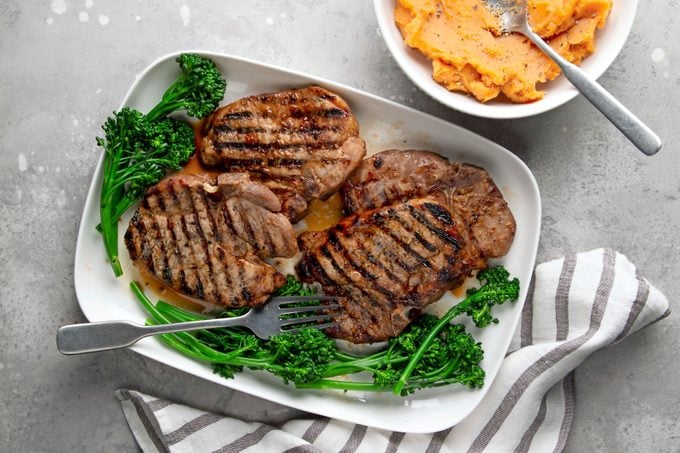How to Cook Pork Chops
Updated: Apr. 28, 2024

Are bone-in or boneless chops better? Can you air fry pork chops? What temperature should they be when done? We answer all these questions and more in this helpful guide on how to cook pork chops.
We love a good pork chop, whether breaded and fried, grilled or stewed with apples and onions. And while pork chops are one of the most economical cuts of meat to buy and are simple to prepare, they’re really easy to overcook. Fortunately, cooking pork chops the right way doesn’t have to be difficult.
Getting moist, tender and flavor-packed chops is all about the cut, thickness, brining or seasoning, cooking method and temperature. Here we’ll show you how to cook the best, juiciest meat for all of your favorite pork chop recipes.
How to Pick Pork Chops
When it comes to picking the best pork chops, you mostly have to decide if you want bone-in or boneless. Here’s the difference.
Bone-In Pork Chops

Like other cuts of meat, bone-in pork chops will render the most flavor, thanks to the bone insulating the meat and keeping it moist and delicious no matter the preparation. Like a good bone-in steak, they’re also super impressive looking on the plate. There are a few options, but we’ll focus on the most common here.
Bone-in rib chops: These are centered by a medallion of lighter pink loin meat with a bone along one side and a line of fat and darker meat along the other. Also known as center-cut rib chop (the bone is actually what you’ll get with baby back ribs), this classic and widely available cut is tender and cooks quickly. It’s perfect for any preparation, from oven-baked pork chops to pork chops with scalloped potatoes. They’re best when cut 1 to 2 inches thick, but 3/4-inch is common. Because it’s fairly lean, you’ll want to use any quick-cooking method, from pan-searing to baking or grilling.
You may also see bone-in shoulder chops and sirloin chops. Because of where they come from in the pig—the shoulder and hip area, respectively—they’re tougher cuts of meat. Like cooking pork shoulder, these are best in long, slow braises and stews.
Bone-in loin chops: These resemble a T-bone steak with its ‘T’ shaped bone in the center. Typically there’s one large round of rib meat on one side of the bone, and a small corner of darker colored tenderloin on the other. Also known as center loin chop, loin pork chop and top-loin chop, these are also best cut 1 to 2 inches thick. Slightly thinner is ok, but thicker chops have a higher tolerance for direct heat, and like rib chops, these do better with a quick hot sear in a pan or grilled, like dry-rub grilled pork chops.
Bone-in rib and loin chops are pretty interchangeable for most easy pork chop recipes. You can brine or use a dry rub for either one, and both can be cooked in different ways. The main thing to keep in mind is that the loin chop has a bit of tenderloin attached, which can cook more quickly than the rib meat. If you want to try variations, then learn how to make simple shake-and-bake pork chops.
Boneless Pork Chops
When you don’t have a lot of time to get dinner on the table, boneless chops are a great choice. They’re basically the same loin and rib cuts as the bone-in chops, only without the bones. Generally light pink in color and delicate in flavor, you’ll find boneless chops cut in various degrees of thickness, from 1/2 inch up to 2 inches thick.
Without the bone and the extra flavor it provides, brining really helps boneless pork chops. Not only will the salty water solution add flavor, but it also provides some moisture to keep those chops juicy. Use boneless pork chops for oven baking, like this pork and asparagus sheet pan dinner, or sauced up like these sweet barbecued pork chops. They’re also perfect for seasoned pan-seared pork chops.
Tips for Cooking Pork Chops

To brine or not to brine, that is the question. Brining pork chops isn’t necessary, but it can help tenderize the meat and keep it flavorful and juicy. The key ingredients for any brine are salt, sugar and water, but you can also add spices, herbs and citrus peel. How long to brine is key, too. Our Test Kitchen suggests brining pork chops 8 to 12 hours for the best taste, but you can get away with a few hours if you can’t go overnight.
A dry rub works much the same way as a brine for pork chops, adding both flavor and helping the chops retain some juiciness. Dry rub recipes run the gamut, but usually contain things like paprika, garlic powder, onion powder, cayenne, sugar, salt and herbs. You can even brine them before adding a spice rub—just make sure to get the chop good and dry before adding the spice mixture.
Whether brined or rubbed, thick or thin, bone-in or boneless, the best pork chop is cooked to the right temperature. And the only way to ensure your pork chops are done to perfection is with a meat thermometer. For the most accurate results, insert the thermometer into the side of the chop. Cooked pork chop temperature is lower than you think: Look for 145 to 150°F for medium-rare chops, and 160° for well-done. But remember: The higher in temp you go, the higher risk of a dry, tough pork chop. Looking for more recipes? Try this French onion pork chops.
How to Cook Pork Chops, 7 Ways
Pork chops are one of the most versatile cuts of meat, lending themselves to every type of cooking technique. Here are our favorites.
How to Fry Pork Chops

Pan-fried pork chops are classic comfort food. Breaded pork chops served with mashed potatoes, corn and plenty of applesauce have fueled generations of families. Most of us have probably eaten overcooked and flavorless pork chops (thank goodness for that applesauce!), but it doesn’t have to be that way.
You can fry pork chops with or without breading. Like with these parmesan-crusted pork chops, the bread crumb coating can help the meat retain some moisture, whether fried in some oil on the stove top or on a sheet pan in the oven. The key is to cook them to the right temperature: That magical 145°. And just like most meat, let it rest for at least 5 minutes before slicing so the juices have a chance to redistribute.
How to Bake Pork Chops
Both bone-in and boneless rib and loin chops are great for baked pork chop recipes. Boneless will take less time to bake in the oven, and bone-in cuts will have a bit more flavor. You don’t need to do much to adorn either, just a few good seasonings or a dry rub will do the trick. These oven-baked bone-in pork chops are easy as can be, as are these special pork chops which make great use of jarred salsa.
How to Air-Fry Pork Chops
Like just about everything else that’s baked or fried, you can cook pork chops in an air fryer. Made with boneless and breaded loin chops, these simple air-fryer pork chops are a breeze to make. You can also use bone-in pork chops in this or any other air-fryer pork chop recipe. Just remember that you may need to adjust the cooking time. Also, depending on the size of your air fryer, you may need to work in batches. Next, try this easy-to-make Southern fried pork chops.
How to Grill Pork Chops

When grilling pork chops, thicker is better. Our Test Kitchen suggests going with a thick-cut, bone-in chop for its fat content (that’s flavor, baby) and barrier to overcooking the meat. Plus, a thicker chop has a higher tolerance for the kind of direct heat you get from a charcoal or gas grill. That high heat helps sear in the juices.
Bone-in chops also look great, even when it’s something like these simple marinated grilled pork chops. To get picture-perfect grill marks, after they’ve seared for 2 to 3 minutes, rotate the chops a quarter turn and cook 2 to 3 more minutes before flipping. Repeat on the other side.
How to Braise Pork Chops
For the most part, cooking loin or rib chops for longer periods of time does not make them more tender. However, there are some delicious slow-cooker pork chop recipes that are pure comfort food.
Along with a low-and-slow temperature and proper cooking liquid, the trick to braising meat is picking the right type of meat to braise. If you want to braise really delicious, fork-tender pork chops, try using the shoulder or sirloin cut, both of which require longer cooking times in a slow cooker, stew or braise.
How to Make Stuffed Pork Chops
You can stuff both bone-in and boneless pork chops, just make sure that the chop is thick enough to stuff. You’ll want to be able to slice a thin opening along the side of the chop without going through the other side.
These savory stuffed pork chops and air-fryer stuffed pork chops are easy to make and look rather elegant for dinner. Yes, even for company! Use leftover or boxed stuffing if you have it, or consider other stuffing options like spinach and cheese or apples.
How to Make Pork Chops in the Instant Pot
Unsurprisingly, the best way to make pork chops in an Instant Pot is with seasonings and a delicious broth or sauce. (Breading doesn’t work so well here.) Boneless loin chops are preferred for this cooking method, but bone-in works fine too. You can even use frozen pork chops if you didn’t have time to thaw them (tip: here’s how to safely thaw pork chops).
Even with the Instant Pot, you want to keep in mind the pork chop’s internal temperature: A perfectly cooked and safe-to-eat pork chop should register at 145°. It doesn’t take that long to get there in an Instant Pot, just about 10 minutes will do it. If you enjoyed this recipe, then learn how to make Crockpot smothered pork chops.
How to Store Pork Chops
In general, any preparation of pork chop will last three to four days in an airtight container in the refrigerator. You can store cooked pork chops in the freezer for up to three months, as well. To freeze, wrap each chop in aluminum foil and store in a freezer-safe bag. Thaw the pork in the refrigerator overnight before reheating.
Reheat pork chops as you would any other meat: In the microwave, on the stovetop, in an air fryer or in the oven. Most pork chops can be reheated in a 350° oven for around 10 minutes. A microwave is the fastest, taking only three to five minutes.



















